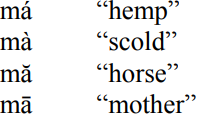
How languages develop tones
 المؤلف:
P. John McWhorter
المؤلف:
P. John McWhorter
 المصدر:
The Story of Human Language
المصدر:
The Story of Human Language
 الجزء والصفحة:
15-3
الجزء والصفحة:
15-3
 2024-01-08
2024-01-08
 1155
1155
How languages develop tones
There are also languages where the pitch at which one utters a syllable determines the very meaning of the word. This is by no means rare; it is typical in East and Southeast Asia and much of Africa. This is another phenomenon created by sound change.
A. How tones work. In Mandarin Chinese, the word ma means different things depending on its tone.

Mandarin has four tones; Cantonese Chinese has six, so that fan can mean “share,” “powder,” “advise,” “divide,” “excited,” or “grave.”
B. How tones emerge. This happens as sounds wear away.
1. Suppose there are three words in a language, pa, pak, and pas. Now, when you say pak, your voice tends to go up a bit, whereas when you say pas, it tends to go down a bit.

2. Normally, one wouldn’t notice this. But suppose in this language, consonants at the end of words started wearing away, just as the s at the end of Latin’s maturus did to create Spanish’s maduro. If this happened, then the only way to tell the words apart would be the pitch differences. This is how tone develops in languages.
Such pronunciations as “rah fish,” then, are symptoms of a general process that helped to transform the first language into the 6,000 new ones that exist today.
 الاكثر قراءة في Linguistics fields
الاكثر قراءة في Linguistics fields
 اخر الاخبار
اخر الاخبار
اخبار العتبة العباسية المقدسة


